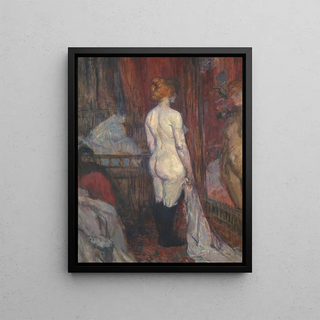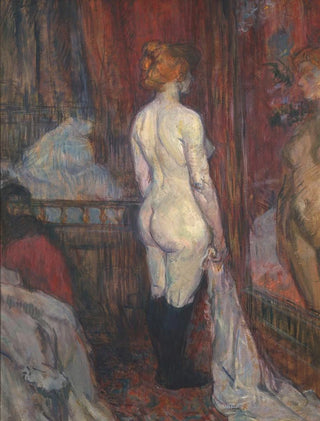Art print | Woman in front of a mirror - Henri de Toulouse-Lautrec


View from behind

Frame (optional)
In the fascinating world of art, certain works stand out for their ability to capture the very essence of humanity. "Femme devant un miroir" by Henri de Toulouse-Lautrec is one of these iconic creations. Painted at the end of the 19th century, this piece embodies the spirit of an era marked by the vibrancy of Parisian cabarets and the emergence of new artistic expressions. The canvas evokes a haunting intimacy, inviting the viewer to delve into the introspection of the depicted woman, while revealing the subtleties of a society in transition. The artist manages to transcend a simple portrait to offer a reflection on beauty, solitude, and the gaze we cast upon ourselves.
Style and uniqueness of the work
Toulouse-Lautrec's style is characterized by a bold color palette and flowing lines that infuse a particular dynamism into his compositions. In "Femme devant un miroir," the softness of pastel tones contrasts with more vivid touches, creating a striking contrast that immediately draws the eye. The woman, with a posture that is both delicate and assertive, appears immersed in silent contemplation, her reflection in the mirror becoming a symbol of duality between appearance and reality. The meticulous details, such as the play of light on her skin and the reflections in the mirror, testify to an exceptional craftsmanship. This work, both intimate and universal, reminds us that the quest for self is a timeless theme, where every gaze upon oneself can be both an act of vulnerability and strength.
The artist and his influence
Henri de Toulouse-Lautrec, an emblematic figure of post-impressionism, captured the soul of the Belle Époque through his works. Born into an aristocratic family, he was quickly drawn to the world of arts and entertainment, becoming a privileged observer of Parisian nightlife. His unique style, blending Japanese influences and elements of popular culture, profoundly marked the artistic landscape of his time. Toulouse-Lautrec knew how to give a voice to the marginalized, artists, and dancers, revealing the hidden beauty

Matte finish

View from behind

Frame (optional)
In the fascinating world of art, certain works stand out for their ability to capture the very essence of humanity. "Femme devant un miroir" by Henri de Toulouse-Lautrec is one of these iconic creations. Painted at the end of the 19th century, this piece embodies the spirit of an era marked by the vibrancy of Parisian cabarets and the emergence of new artistic expressions. The canvas evokes a haunting intimacy, inviting the viewer to delve into the introspection of the depicted woman, while revealing the subtleties of a society in transition. The artist manages to transcend a simple portrait to offer a reflection on beauty, solitude, and the gaze we cast upon ourselves.
Style and uniqueness of the work
Toulouse-Lautrec's style is characterized by a bold color palette and flowing lines that infuse a particular dynamism into his compositions. In "Femme devant un miroir," the softness of pastel tones contrasts with more vivid touches, creating a striking contrast that immediately draws the eye. The woman, with a posture that is both delicate and assertive, appears immersed in silent contemplation, her reflection in the mirror becoming a symbol of duality between appearance and reality. The meticulous details, such as the play of light on her skin and the reflections in the mirror, testify to an exceptional craftsmanship. This work, both intimate and universal, reminds us that the quest for self is a timeless theme, where every gaze upon oneself can be both an act of vulnerability and strength.
The artist and his influence
Henri de Toulouse-Lautrec, an emblematic figure of post-impressionism, captured the soul of the Belle Époque through his works. Born into an aristocratic family, he was quickly drawn to the world of arts and entertainment, becoming a privileged observer of Parisian nightlife. His unique style, blending Japanese influences and elements of popular culture, profoundly marked the artistic landscape of his time. Toulouse-Lautrec knew how to give a voice to the marginalized, artists, and dancers, revealing the hidden beauty






